Evaluation of the Antioxidant Activity of Nigella sativa L. and Allium ursinum Extracts in a Cellular Model of Doxorubicin-Induced Cardiotoxicity
Abstract
1. Introduction
2. Materials and Methods
2.1. Reagents and Standards
2.2. Plant Material
2.3. Extraction Method
2.4. Total Polyphenol Content (TPC)
2.5. Antioxidant Activity Test
2.6. FTIR Analysis
2.7. Liquid Chromatography-Diode Array Detection–Electro-Spray Ionization Mass Spectrometry (HPLC-DAD-ESI MS)
2.8. ITEX/GC-MS Qualitative Analysis of Volatile Compounds
2.9. Cell Culture
2.10. Viability Assay
2.11. Measurement of Intracellular ROS
2.12. Measurement of Mitochondrial Superoxide Evaluation with MitoSOX Red
2.13. Measurement Mitochondrial Membrane Depolarization with TMRE
2.14. Data Analysis
3. Results
3.1. FT-IR Analysis
3.2. LC-MS Analysis
3.3. ITEX/GC-MS Analysis
3.4. Effect of NSS and AU Extracts on Cell Viability Assay
3.5. Effect of NSS and AU Extracts on Doxo-Induced ROS Release
3.6. Effect of NSS and AU Extracts on Doxo-Induced Mitochondrial ROS Release
3.7. Effect of NSS and AU Extracts on Doxo-Induced Mitochondrial Membrane Depolarization
4. Discussion
5. Conclusions
Author Contributions
Funding
Conflicts of Interest
References
- WHO. Cardiovascular Diseases. 2017. Available online: http://www.who.int/news-room/fact-sheets/detail/cardiovascular-diseases-(cvds) (accessed on 28 August 2018).
- Tzoulaki, I.; Elliott, P.; Kontis, V.; Ezzati, M. Worldwide Exposures to Cardiovascular Risk Factors and Associated Health Effects. Circulation 2016, 133, 2314–2333. [Google Scholar] [CrossRef] [PubMed]
- Page, R.L.; O’Bryant, C.L.; Cheng, D.; Dow, T.J.; Ky, B.; Stein, C.M.; Spencer, A.P.; Trupp, R.J.; Lindenfeld, J. Drugs That May Cause or Exacerbate Heart Failure. Circulation 2016, 134, 32. [Google Scholar] [CrossRef]
- Henriksen, A.P. Anthracycline cardiotoxicity: An update on mechanisms, monitoring and prevention. Heart 2017, 104, 971–977. [Google Scholar] [CrossRef] [PubMed]
- Pecoraro, M.; Rodríguez-Sinovas, A.; Marzocco, S.; Ciccarelli, M.; Iaccarino, G.; Pinto, A.; Popolo, A. Cardiotoxic Effects of Short-Term Doxorubicin Administration: Involvement of Connexin 43 in Calcium Impairment. Int. J. Mol. Sci. 2017, 18, 2121. [Google Scholar] [CrossRef] [PubMed]
- Bansal, N.; Adams, M.J.; Ganatra, S.; Colan, S.D.; Aggarwal, S.; Steiner, R.; Amdani, S.; Lipshultz, E.R.; Lipshultz, S.E. Strategies to prevent anthracycline-induced cardiotoxicity in cancer survivors. Cardio-Oncology 2019, 5, 18. [Google Scholar] [CrossRef]
- Del Buono, M.G.; Iannaccone, G.; Scacciavillani, R.; Carbone, S.; Camilli, M.; Niccoli, G.; Borlaug, B.A.; Lavie, C.J.; Arena, R.; Crea, F.; et al. Heart failure with preserved ejection fraction diagnosis and treatment: An updated review of the evidence. Prog. Cardiovasc. Dis. 2020. [Google Scholar] [CrossRef]
- Kovačević, M.; Kovačević, S.V.; Radovanović, S.; Stevanović, P.; Miljković, B. Adverse drug reactions caused by drug–drug interactions in cardiovascular disease patients: Introduction of a simple prediction tool using electronic screening database items. Curr. Med. Res. Opin. 2019, 35, 1873–1883. [Google Scholar] [CrossRef]
- Roy, A.; Roy, A.; Sachdeva, V. Current Prospects of Nutraceuticals: A Review. Curr. Pharm. Biotechnol. 2020, 21, 884–896. [Google Scholar] [CrossRef]
- USA Nutraceutical Market to 2027: Increasing Spectrum of Nutraceutical in Sport Nutrition & Pet Food. Available online: https://www.prnewswire.com/news-releases/usa-nutraceutical-market-to-2027-increasing-spectrum-of-nutraceutical-in-sport-nutrition--pet-food-300905970.html (accessed on 22 November 2019).
- Shaikh, A.S.; Thomas, A.B.; Chitlange, S.S. Herb–drug interaction studies of herbs used in treatment of cardiovascular disorders—A narrative review of preclinical and clinical studies. Phytother. Res. 2020, 34, 1008–1026. [Google Scholar] [CrossRef]
- Shabana, A.; El-Menyar, A.; Asim, M.; Al-Azzeh, H.; Al Thani, H. Cardiovascular Benefits of Black Cumin (Nigella sativa). Cardiovasc. Toxicol. 2013, 13, 9–21. [Google Scholar] [CrossRef]
- Petropoulos, S.A.; Di Gioia, F.; Polyzos, N.; Tzortzakis, N. Natural Antioxidants, Health Effects and Bioactive Properties of Wild Allium Species. Curr. Pharm. Des. 2020, 26, 1816–1837. [Google Scholar] [CrossRef] [PubMed]
- Pop, R.M.; Trifa, A.P.; Popolo, A.; Chedea, V.S.; Militaru, C.; Bocsan, I.C.; Buzoianu, A.D. Nigella sativa: Valuable perspective in the management of chronic diseases. Iran. J. Basic Med. Sci 2020, 23, 699–713. [Google Scholar] [PubMed]
- Badar, A.; Kaatabi, H.; Bamosa, A.O.; Al-Elq, A.; Abou-Hozaifa, B.; Lebda, F.; Al-Khadra, A.; Al-Almaie, S. Effect of Nigella sativa supplementation over a one-year period on lipid levels, blood pressure and heart rate in type-2 diabetic patients receiving oral hypoglycemic agents: Nonrandomized clinical trial. Ann. Saudi Med. 2017, 37, 56–63. [Google Scholar] [CrossRef] [PubMed]
- Roghani-Dehkordi, F.; Kamkhah, A.F. Antihypertensive effect of Nigella sativa seed extract in patients with mild hypertension. Fundam. Clin. Pharmacol. 2008, 22, 447–452. [Google Scholar] [CrossRef]
- Kaatabi, H.; Bamosa, A.; Badar, A.; Al-Elq, A.; Abou-Hozaifa, B.; Lebda, F.; Al-Khadra, A.; Al-Almaie, S. Nigella sativa Improves Glycemic Control and Ameliorates Oxidative Stress in Patients with Type 2 Diabetes Mellitus: Placebo Controlled Participant Blinded Clinical Trial. PLoS ONE 2015, 10, e0113486. [Google Scholar] [CrossRef]
- El Tahir, K.E.H.; Al-Ajmi, M.F.; Al-Bekairi, A.M. Some cardiovascular effects of the dethymoquinonated Nigella sativa volatile oil and its major components α-pinene and p-cymene in rats. Saudi Pharm. J. 2003, 11, 104–110. [Google Scholar]
- Leong, X.-F.; Rais, M.M.; Jaarin, K. Nigella sativaand Its Protective Role in Oxidative Stress and Hypertension. Evid. Based Complementary Altern. Med. 2013, 2013, 120732. [Google Scholar] [CrossRef]
- Toma, C.-C.; Olah, N.-K.; Vlase, L.; Mogoșan, C.; Mocan, A. Comparative Studies on Polyphenolic Composition, Antioxidant and Diuretic Effects of Nigella sativa L. (Black Cumin) and Nigella damascena L. (Lady-in-a-Mist) Seeds. Molecules 2015, 20, 9560–9574. [Google Scholar] [CrossRef]
- Vesa, Ş.C.; Sava, M. The Use of Nigella sativa in Various Cardiovascular Diseases. In Future Perspectives on Nigella sativa: Characterization and Pharmacological Properties; Pop, R.M., Ed.; Nova Science Publishers, Inc.: Hauppauge, NY, USA, 2018; ISBN 978-1-53613-429-2. [Google Scholar]
- Al-Naqeep, G.; Al-Zubairi, A.S.; Ismail, M.; Amom, Z.H.; Esa, N.M. Antiatherogenic Potential of Nigella sativa Seeds and Oil in Diet-Induced Hypercholesterolemia in Rabbits. Evid. Based Complementary Altern. Med. 2011, 2011, 213628. [Google Scholar] [CrossRef]
- Seif, A.A. Nigella sativa attenuates myocardial ischemic reperfusion injury in rats. J. Physiol. Biochem. 2013, 69, 937–944. [Google Scholar] [CrossRef]
- Farzaneh, E.; Nia, F.R.; Mehrtash, M.; Mirmoeini, F.S.; Jalilvand, M. The Effects of 8-week Nigella sativa Supplementation and Aerobic Training on Lipid Profile and VO2 max in Sedentary Overweight Females. Int. J. Prev. Med. 2014, 5, 210–216. [Google Scholar] [PubMed]
- Qidwai, W.; Ashfaq, T. Role of Garlic Usage in Cardiovascular Disease Prevention: An Evidence-Based Approach. Evid. Based Complementary Altern. Med. 2013, 2013, 125649. [Google Scholar] [CrossRef] [PubMed]
- Sobolewska, D.; Podolak, I.; Makowska-Wąs, J. Allium ursinum: Botanical, phytochemical and pharmacological overview. Phytochem. Rev. 2015, 14, 81–97. [Google Scholar] [CrossRef] [PubMed]
- Vlase, L.; Parvu, M.; Parvu, A.E.; Toiu, A. Chemical Constituents of Three Allium Species from Romania. Molecules 2012, 18, 114–127. [Google Scholar] [CrossRef] [PubMed]
- Pârvu, M.; Moţ, C.A.; Parvu, A.E.; Mircea, C.; Stoeber, L.; Roşca-Casian, O.; Tigu, A.-B. Allium sativum Extract Chemical Composition, Antioxidant Activity and Antifungal Effect against Meyerozyma guilliermondii and Rhodotorula mucilaginosa Causing Onychomycosis. Molecules 2019, 24, 3958. [Google Scholar] [CrossRef]
- Preuss, H.G.; Clouatre, D.; Mohamadi, A.; Jarrell, S.T. Wild garlic has a greater effect than regular garlic on blood pressure and blood chemistries of rats. Int. Urol. Nephrol. 2001, 32, 525–530. [Google Scholar] [CrossRef]
- Juhász, B.; Priksz, D.; Varga, B.; Gesztelyi, R.; Kertész, A.; Lengyel, P.; Balogh, P.; Csupor, D.; Hohmann, J.; Bhattoa, H.P.; et al. Anti-Atherogenic Properties of Allium ursinum Liophylisate: Impact on Lipoprotein Homeostasis and Cardiac Biomarkers in Hypercholesterolemic Rabbits. Int. J. Mol. Sci. 2016, 17, 1284. [Google Scholar] [CrossRef]
- Hiyasat, B.; Sabha, D.; Kempfert, J.; Rauwald, J.-W.; Dhein, S.; Grötzinger, K.; Mohr, F.-W. Antiplatelet Activity of Allium ursinum and Allium sativum. Pharmacology 2009, 83, 197–204. [Google Scholar] [CrossRef]
- Lorigooini, Z.; Ayatollahi, S.A.; Amidi, S.; Kobarfard, F. Evaluation of Anti-Platelet Aggregation Effect of Some Allium Species. Iran. J. Pharm. Res. 2015, 14, 1225–1231. [Google Scholar]
- Wong, J.; Smith, L.B.; Magun, E.A.; Engstrom, T.; Kelley-Howard, K.; Jandhyala, D.M.; Thorpe, C.M.; Magun, B.E.; Wood, L.J. Small molecule kinase inhibitors block the ZAK-dependent inflammatory effects of doxorubicin. Cancer Biol. Ther. 2012, 14, 56–63. [Google Scholar] [CrossRef]
- Pecoraro, M.; Sorrentino, R.; Franceschelli, S.; Del Pizzo, M.; Pinto, A.; Popolo, A. Doxorubicin-Mediated Cardiotoxicity: Role of Mitochondrial Connexin 43. Cardiovasc. Toxicol. 2015, 15, 366–376. [Google Scholar] [CrossRef] [PubMed]
- Pop, R.M.; Puia, I.C.; Puia, A.; Chedea, V.S.; Leopold, N.; Bocsan, I.C.; Buzoianu, A.D. Characterization of Trametes versicolor: Medicinal Mushroom with Important Health Benefits. Not. Bot. Horti Agrobot. Cluj-Napoca 2018, 46, 343–349. [Google Scholar] [CrossRef]
- Brand-Williams, W.; Cuvelier, M.; Berset, C. Use of a free radical method to evaluate antioxidant activity. LWT 1995, 28, 25–30. [Google Scholar] [CrossRef]
- Pop, R.M.; Socaciu, C.; Pintea, A.; Buzoianu, A.D.; Sanders, M.G.; Gruppen, H.; Vincken, J.-P. UHPLC/PDA-ESI/MS Analysis of the Main Berry and Leaf Flavonol Glycosides from Different Carpathian Hippophaë rhamnoides L. Varieties. Phytochem. Anal. 2013, 24, 484–492. [Google Scholar] [CrossRef]
- Pop, R.M.; Sabin, O.; Suciu, Ș.; Vesa, Ş.C.; Socaci, S.A.; Chedea, V.S.; Bocșan, I.C.; Buzoianu, A.D. Nigella sativa’s Anti-Inflammatory and Antioxidative Effects in Experimental Inflammation. Antioxidants 2020, 9, 921. [Google Scholar] [CrossRef]
- Pop, R.M.; Buzoianu, A.D.; Rați, I.V.; Socaciu, C. Untargeted Metabolomics for Sea Buckthorn (Hippophae rhamnoides ssp. carpatica) Berries and Leaves: Fourier Transform Infrared Spectroscopy as a Rapid Approach for Evaluation and Discrimination. Not. Bot. Horti Agrobot. Cluj-Napoca 2014, 42, 545–550. [Google Scholar] [CrossRef]
- Mohammed, S.J.; Amin, H.H.H.; Aziz, S.B.; Sha, A.M.; Hassan, S.; Aziz, J.M.A.; Rahman, H.S. Structural Characterization, Antimicrobial Activity, and in Vitro Cytotoxicity Effect of Black Seed Oil. Evid. Based Complement. Altern. Med. 2019, 2019, 6515671. [Google Scholar] [CrossRef]
- Nikkhahi, M.; Souri, E.; Sarkhail, P.; Baeeri, M.; Mohammadhosseini, N. Evaluation of anti-tyrosinase activity of Allium ursinum extracts and their metal complexes. Acta Sci. Pol. Technol. Aliment. 2018, 17, 219–226. [Google Scholar] [CrossRef]
- Heneczkowski, M.; Kopacz, M.; Nowak, D.; Kuźniar, A. Infrared spectrum analysis of some flavonoids. Acta Pol. Pharm. Drug Res. 2002, 58, 415–420. [Google Scholar]
- Nagarajan, D.; Kumar, T.R. Fourier transform infrared spectroscopy analysis of garlic (Allium) D. Int. J. Zool. Stud. 2017, 2, 11–14. [Google Scholar]
- Valderrama, A.C.S.; De, G.C.R. Traceability of Active Compounds of Essential Oils in Antimicrobial Food Packaging Using a Chemometric Method by ATR-FTIR. Am. J. Anal. Chem. 2017, 8, 726–741. [Google Scholar] [CrossRef]
- Topcagic, A.; Sanja, Ć.; Karalija, E.; Galijasevic, S.; Sofic, E. Evaluation of phenolic profile, enzyme inhibitory and antimicrobial activities of Nigella sativa L. seed extracts. Bosn. J. Basic Med. Sci. 2017, 17, 286–294. [Google Scholar] [CrossRef] [PubMed]
- Malešević, V.K.; Vaštag, Ž.; Popović, L.; Popovic, S.; Peričin-Starčević, I. Characterisation of black cumin, pomegranate and flaxseed meals as sources of phenolic acids. Int. J. Food Sci. Technol. 2013, 49, 210–216. [Google Scholar] [CrossRef]
- Farag, M.A.; Gad, H.A.; Heiss, A.G.; Wessjohann, L.A. Metabolomics driven analysis of six Nigella species seeds via UPLC-qTOF-MS and GC–MS coupled to chemometrics. Food Chem. 2014, 151, 333–342. [Google Scholar] [CrossRef] [PubMed]
- Phan, A.D.T.; Netzel, G.; Chhim, P.; Netzel, M.E.; Sultanbawa, Y. Phytochemical Characteristics and Antimicrobial Activity of Australian Grown Garlic (Allium sativum, L.) Cultivars. Foods 2019, 8, 358. [Google Scholar] [CrossRef] [PubMed]
- Ivanova, A.; Mikhova, B.; Najdenski, H.; Tsvetkova, I.; Kostova, I. Chemical composition and antimicrobial activity of wild garlic Allium ursinum of Bulgarian origin. Nat. Prod. Commun. 2009, 4, 1059–1062. [Google Scholar] [CrossRef]
- Oszmiański, J.; Kolniak-Ostek, J.; Wojdyło, A. Characterization and Content of Flavonol Derivatives of Allium ursinum L. Plant. J. Agric. Food Chem. 2012, 61, 176–184. [Google Scholar] [CrossRef]
- Lachowicz, S.; Kolniak-Ostek, J.; Oszmiański, J.; Wiśniewski, R. Influence of Maturity on the Content of Phenolic Compounds of Alium ursinum L. J. Food Process. Preserv. 2016, 41, e13089. [Google Scholar] [CrossRef]
- Farag, M.A.; Ali, S.E.; Hodaya, R.H.; El-Seedi, H.R.; Sultani, H.N.; Laub, A.; Eissa, T.F.; Abou-Zaid, F.O.F.; Wessjohann, L.A. Phytochemical Profiles and Antimicrobial Activities of Allium cepa Red cv. and A. sativum Subjected to Different Drying Methods: A Comparative MS-Based Metabolomics. Molecules 2017, 22, 761. [Google Scholar] [CrossRef]
- Hameed, S.; Imran, A.; Nisa, M.U.; Arshad, M.S.; Saeed, F.; Khan, M.A. Characterization of extracted phenolics from black cumin (Nigella sativa linn), coriander seed (Coriandrum sativum L.), and fenugreek seed (Trigonella foenum-graecum). Int. J. Food Prop. 2019, 22, 714–726. [Google Scholar] [CrossRef]
- Piatkowska, E.; Kopeć, A.; Leszczyńska, T. Basic Chemical Composition, Content of Micro- and Macroelements and Antio Xidant Activity of Different Varieties of Garlic’s Leaves Polish Origin. Żywność Nauka Technol. Jakość 2015, 22, 181–192. [Google Scholar] [CrossRef]
- Pejatović, T.; Samardžić, D.; Krivokapić, S. Antioxidative properities of a traditional tincture and several leaf extracts of Allium ursinum L. (collected in Montenegro and Bosnia and Herzegovina). T. J. Mater. Environ. Sci. 2017, 8, 1929–1934. [Google Scholar]
- Saleh, F.A.; El Darra, N.; Raafat, K.; El-Ghazzawi, I. Phytochemical Analysis of Nigella sativa L. Utilizing GC-MS Exploring its Antimicrobial Effects against Multidrug-Resistant Bacteria. Pharmacogn. J. 2017, 10, 99–105. [Google Scholar] [CrossRef]
- Kainama, H.; Fatmawati, S.; Santoso, M.; Papilaya, P.M.; Ersam, T. The Relationship of Free Radical Scavenging and Total Phenolic and Flavonoid Contents of Garcinia lasoar PAM. Pharm. Chem. J. 2020, 53, 1151–1157. [Google Scholar] [CrossRef]
- Lawson, L.D. Garlic: A Review of Its Medicinal Effects and Indicated Active Compounds. ACS Symp. Ser. 1998, 691, 176–209. [Google Scholar] [CrossRef]
- Tepe, B.; Sokmen, M.; Akpulat, H.; Sokmen, A. In vitro antioxidant activities of the methanol extracts of five species from Turkey. Food Chem. 2005, 92, 89–92. [Google Scholar] [CrossRef]
- Putnoky, S.; Caunii, A.; Butnariu, M. Study on the stability and antioxidant effect of the Allium ursinum watery extract. Chem. Cent. J. 2013, 7, 21. [Google Scholar] [CrossRef]
- Stajner, D.; Szöllôsi Varga, I. An evaluation of the antioxidant abilities of Allium species. Acta Biol. Szeged. 2003, 47, 103–106. [Google Scholar]
- Hosseini, A.; Shafiee-Nick, R.; Mousavi, S.H. Combination of Nigella sativa with Glycyrrhiza glabra and Zingiber officinale augments their protective effects on doxorubicin-induced toxicity in h9c2 cells. Iran. J. Basic Med. Sci. 2014, 17, 993–1000. [Google Scholar]
- Ahmed, A.; Hassanein, K.M.A. Cardio protective effects of Nigella sativa oil on lead induced cardio toxicity: Anti inflammatory and antioxidant mechanism. J. Physiol. Pathophysiol. 2013, 4, 72–80. [Google Scholar] [CrossRef]
- Al-Shabanah, A.O.; Badary, A.; Nagi, O.; Al-Gharably, M.N.; Al-Rikabi, N.M.; Al-Bekairi, A.C. Thymoquinone protects against doxorubicin-induced cardiotoxicity without compromising its antitumor activity. J. Exp. Clin. Cancer Res. 1998, 17, 193–198. [Google Scholar] [PubMed]
- Kruk, I.; Michalska, T.; Lichszteld, K.; Kładna, A.; Aboul-Enein, H.Y. The effect of thymol and its derivatives on reactions generating reactive oxygen species. Chemosphere 2000, 41, 1059–1064. [Google Scholar] [CrossRef]
- Kuznetsov, A.V.; Margreiter, R.; Amberger, A.; Saks, V.; Grimm, M. Changes in mitochondrial redox state, membrane potential and calcium precede mitochondrial dysfunction in doxorubicin-induced cell death. Biochim. Biophys. Acta Mol. Cell Res. 2011, 1813, 1144–1152. [Google Scholar] [CrossRef] [PubMed]
- Wu, Y.-Z.; Zhang, L.; Wu, Z.-X.; Shan, T.-T.; Xiong, C. Berberine Ameliorates Doxorubicin-Induced Cardiotoxicity via a SIRT1/p66Shc-Mediated Pathway. Oxid. Med. Cell. Longev. 2019, 2019, 2150394. [Google Scholar] [CrossRef]
- Wei, L.; Surma, M.; Gough, G.; Shi, S.; Lambert-Cheatham, N.; Chang, J.; Shi, J. Dissecting the Mechanisms of Doxorubicin and Oxidative Stress-Induced Cytotoxicity: The Involvement of Actin Cytoskeleton and ROCK1. PLoS ONE 2015, 10, e0131763. [Google Scholar] [CrossRef]
- Scholz, E.P.; Zitron, E.; Katus, H.A.; Karle, C.A. Cardiovascular Ion Channels as a Molecular Target of Flavonoids. Cardiovasc. Ther. 2010, 28, e46–e52. [Google Scholar] [CrossRef]
- Park, S.J.; Choi, K.S.; Shin, D.H.; Kim, J.S.; Jang, D.S.; Youm, J.B.; Choe, H.; Earm, Y.E.; Kim, S.J. Effects of Mixed Herbal Extracts from Parched Puerariae Radix, Gingered Magnoliae Cortex, Glycyrrhizae Radix and Euphorbiae Radix (KIOM-79) on Cardiac Ion Channels and Action Potentials. J. Korean Med. Sci. 2009, 24, 403–412. [Google Scholar] [CrossRef][Green Version]
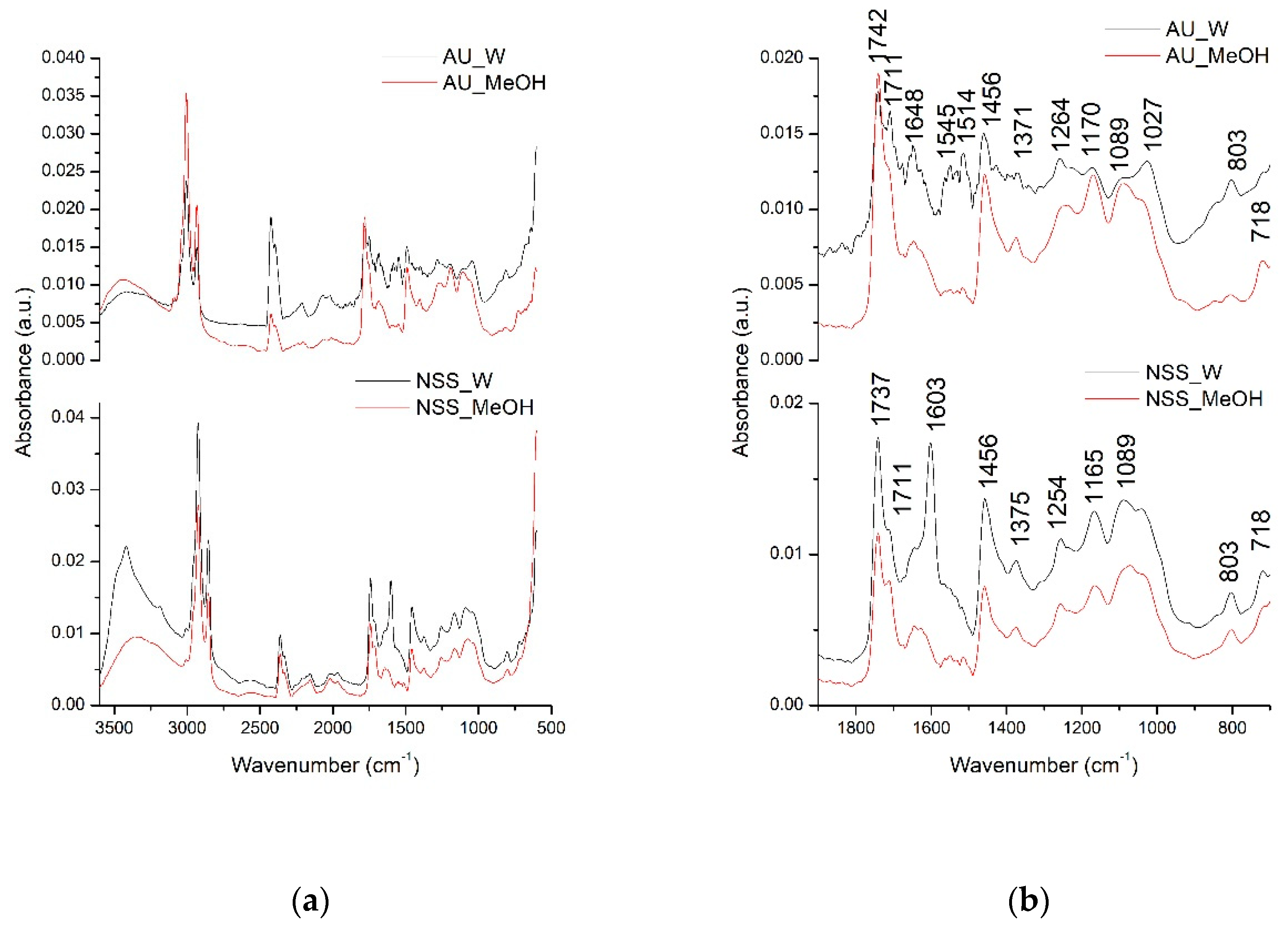
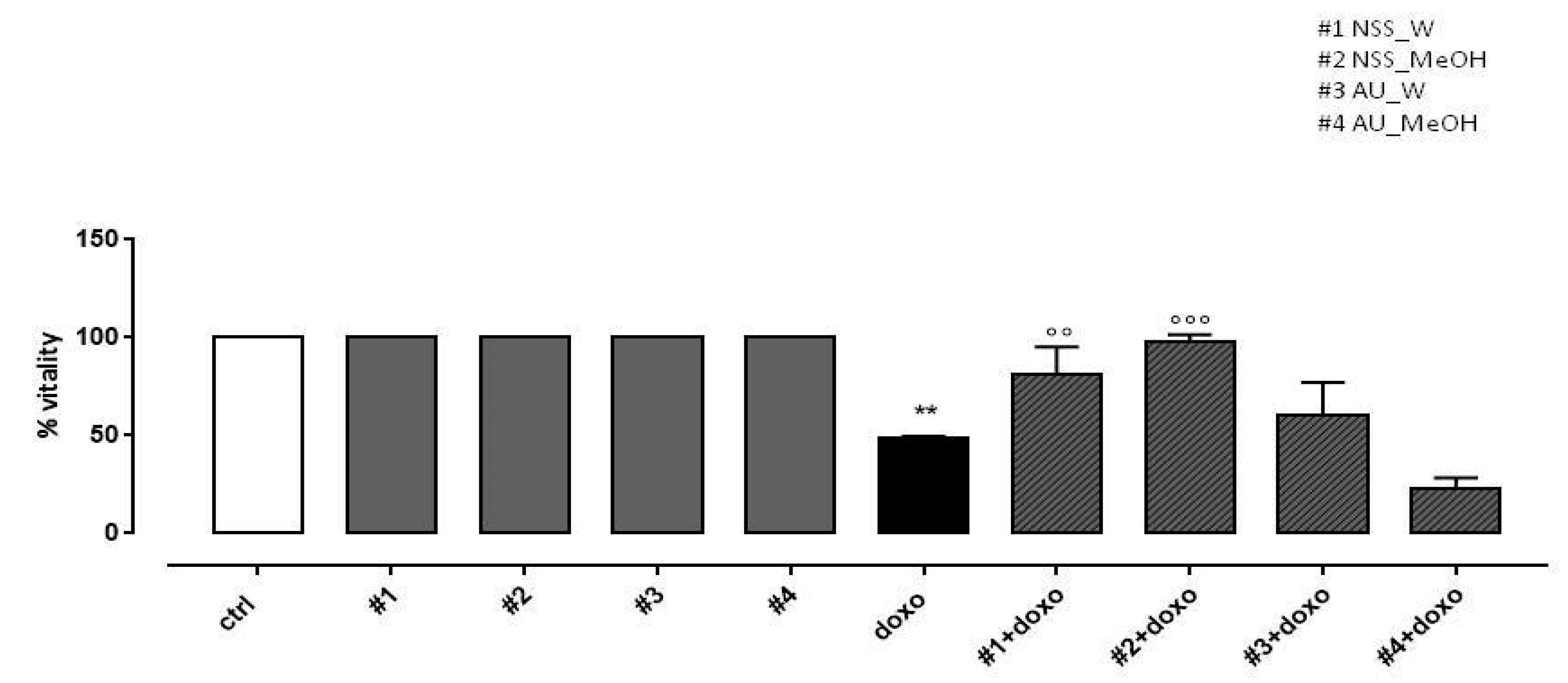
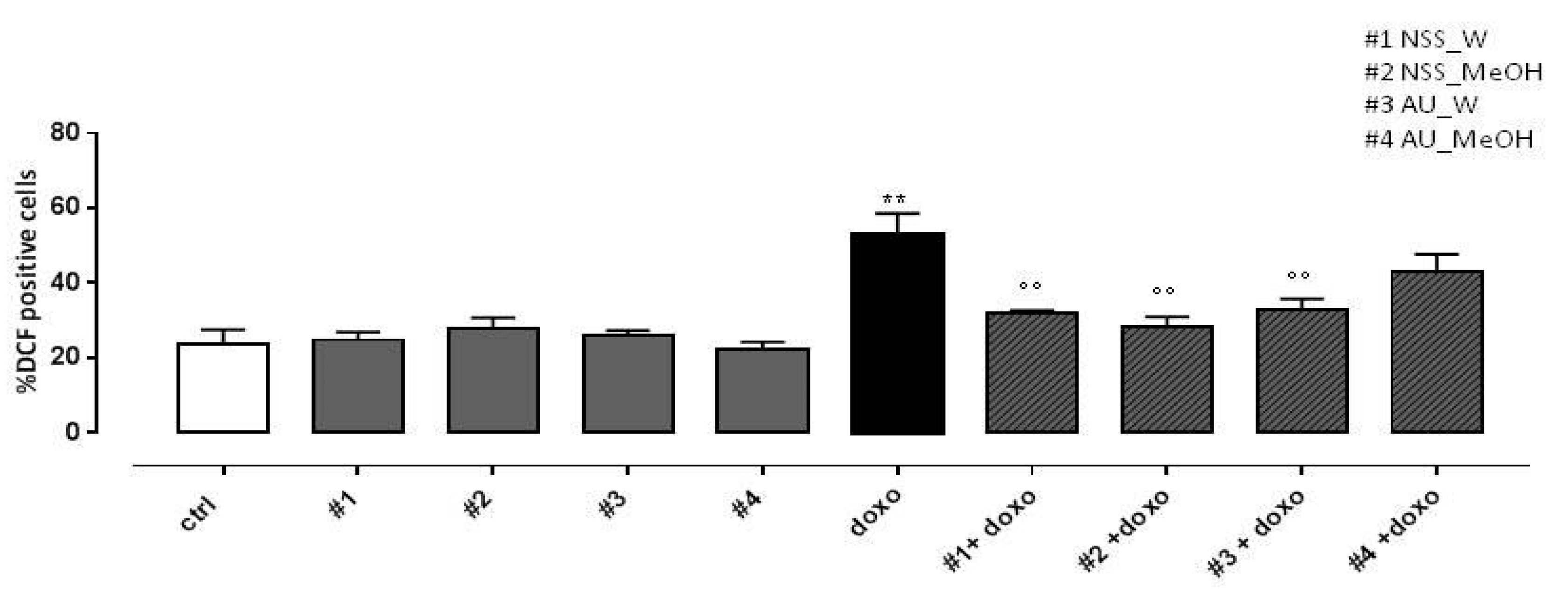
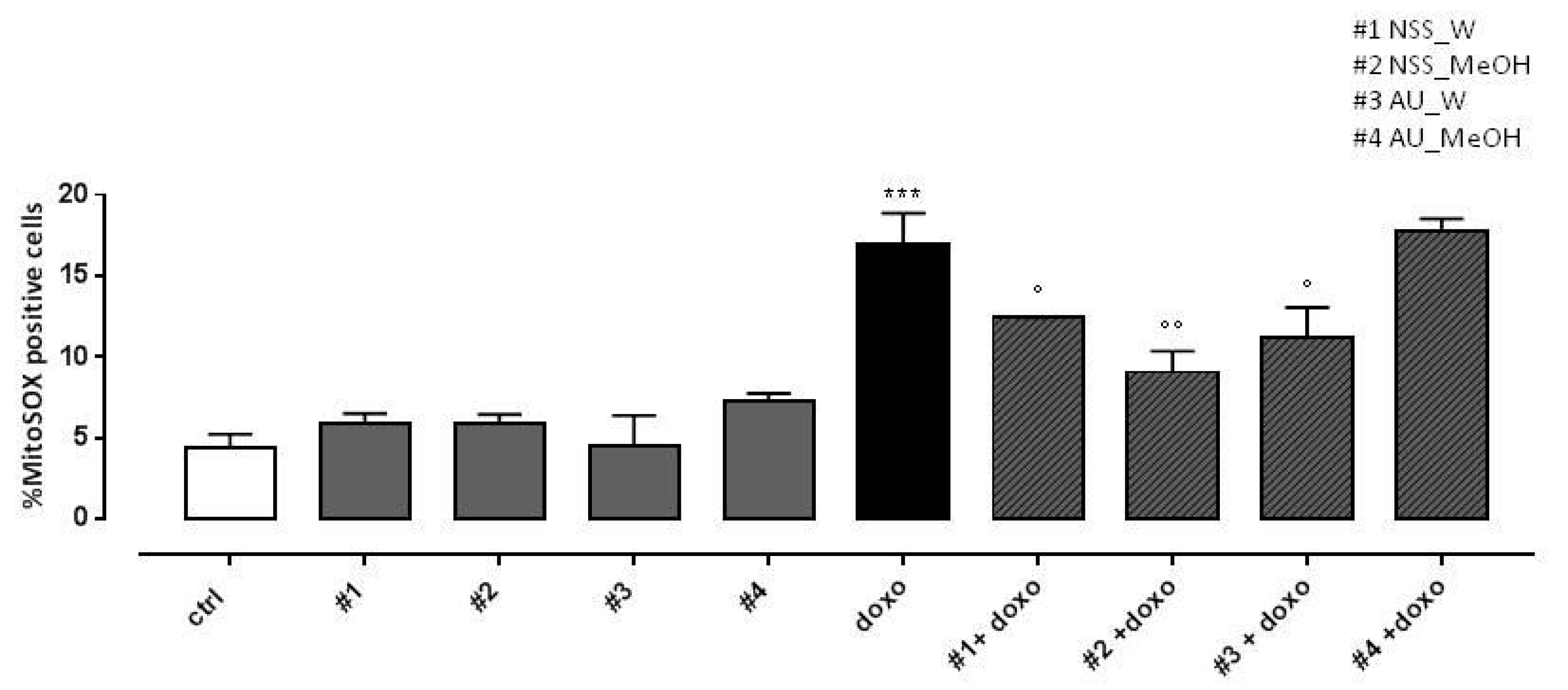
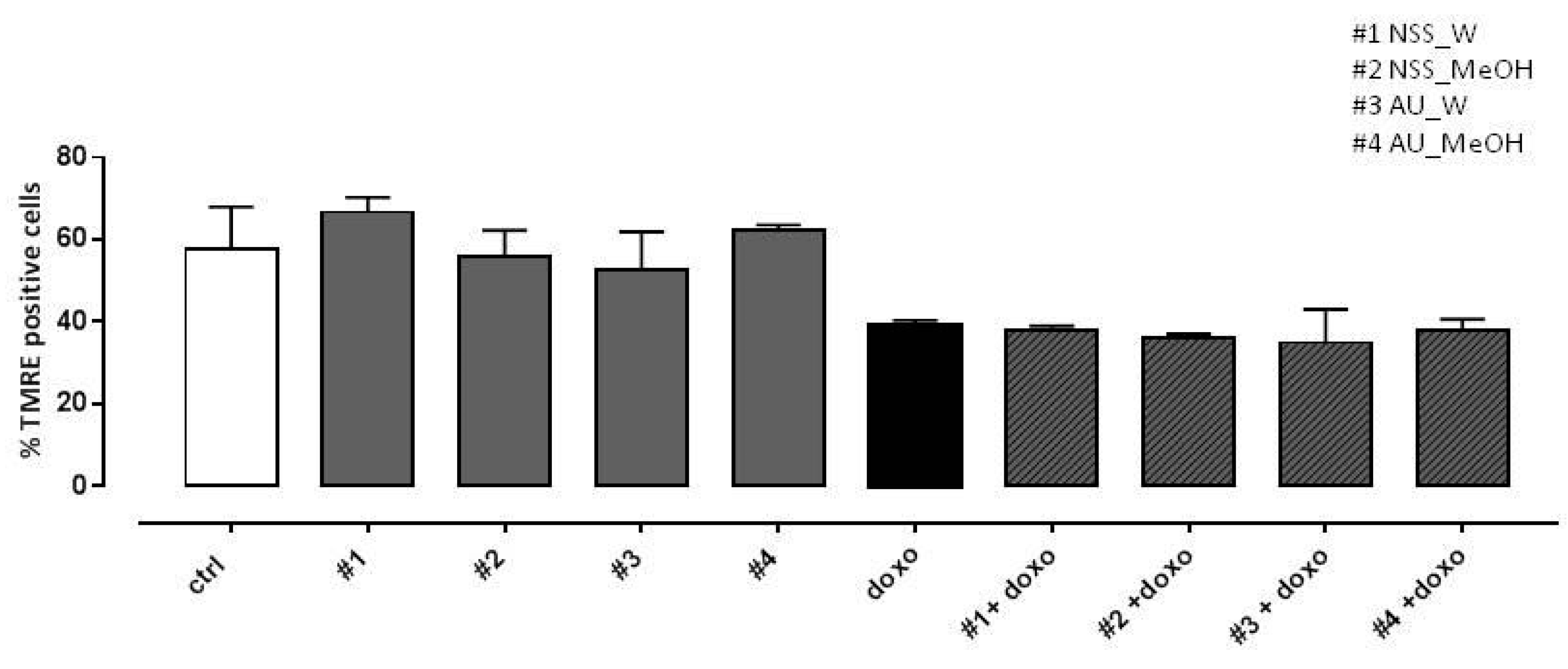
| Samples | TPC (mg GAE/g DW) | DPPH (mM TE/g DW) |
|---|---|---|
| NSS_W | 1.80 ± 0.06 | 297.30 ± 1.27 |
| NSS_MeOH | 2.23 ± 0.13 | 488.37 ± 1.20 |
| AU_W | 2.46 ± 0.12 | 158.47 ± 1.55 |
| AU_MeOH | 2.70 ± 0.08 | 312.15 ± 1.26 |
| No | Time | M/[M + H]+ | λmax (nm) | Tentative Identification | Concentration mg/g Dry Weight (Thymol Equivalents) | References | |
|---|---|---|---|---|---|---|---|
| NSS_W | NSS_MeOH | ||||||
| 1 | 2.95 | 224 | 275 | Sinapic acid | 14.28 ± 0.09 | 8.56 ± 0.07 | [45] |
| 2 | 4.07 | 138 | 270 | Hydroxybenzoic acid | 4.17 ± 0.05 | 2.43 ± 0.06 | [46] |
| 3 | 7.87 | 792 | 290 | Unknown | 3.88 ± 0.05 | 2.54 ± 0.06 | - |
| 4 | 10.23 | 432 | 298 | Benzyl alcohol dihexoside | 6.38 ± 0.04 | 5.12 ± 0.06 | [47] |
| 5 | 12.66 | 198 | 278, 320 | Syringic acid | 5.21 ± 0.08 | 4.78 ± 0.11 | [46] |
| 6 | 13.5 | 196 | 295 | Damascenine | 2.18 ± 0.06 | 2.24 ± 0.07 | [47] |
| 7 | 13.95 | 342 | 278, 300 | Norargemonine | 3.61 ± 0.06 | 8.89 ± 0.05 | [47] |
| 8 | 14.27 | 772 | 270, 350 | Quercetin-rhamnosyl-diglucopyranoside | 4.76 ± 0.03 | 6.00 ± 0.04 | [47] |
| 9 | 16.39 | 594 | 265, 335 | Kaempferol-rhamnosyl-diglucoside | 0.56 ± 0.04 | 0.82 ± 0.05 | [47] |
| 10 | 17.14 | 755 | 265, 355 | Kaempferol-rhamnosyl- Diglucopyranoside | 1.57 ± 0.06 | 3.27 ± 0.05 | [47] |
| 11 | 21.21 | 474 | 260, 300 | Thymol-sophoroside | 2.13 ± 0.05 | 1.62 ± 0.10 | [47] |
| 12 | 23.25 | 286 | 260, 353 | Kaempferol | 1.60 ± 0.05 | 4.96 ± 0.13 | [47] |
| 13 | 24.98 | 150 | 260 | Thymol | 1.36 ± 0.07 | 5.09 ± 0.06 | [47] |
| No | Time | M/[M + H]+ | λmax (nm) | Tentative Identification | Concentration mg/g Dry Weight (Thymol Equivalents) | References | |
|---|---|---|---|---|---|---|---|
| AU_W | AU_MeOH | ||||||
| 1 | 2.99 | 164 | 217, 280 | Coumaric acid | 44.49 ± 0.02 | 39.64 ± 0.07 | [48] |
| 2 | 3.11 | 194 | 218, 295 | Ferulic acid | 11.97 ± 0.03 | 16.08 ± 0.04 | [48] |
| 3 | 3.19 | 224 | 238, 326 | Sinapic acid | 12.53 ± 0.03 | 13.78 ± 0.03 | [48] |
| 4 | 4.06 | 298 | 270 | Unknown | 17.26 ± 0.03 | 18.68 ± 0.06 | - |
| 5 | 11.37 | 756 | 265, 355 | Kaempferol-glucosyl-rhamnosyl-glucoside | 4.17 ± 0.04 | 9.03 ± 0.03 | - |
| 6 | 12.67 | 448 | 264, 350 | Kaempferol-glucopyranoside | 8.34 ± 0.04 | 6.48 ± 0.04 | [49] |
| 7 | 14.63 | 540 | 230, 267, 320 | Unknown | 9.97 ± 0.02 | 20.87 ± 0.05 | - |
| 8 | 15.73 | 490 | 260, 330 | Kaempferol-acetylglucoside | 6.02 ± 0.04 | 12.78 ± 0.05 | [50] |
| 9 | 16.14 | 903 | 265, 315 | Kaempferol-deoxyhexose-hexoside -p-coumaroyl hexoside derivative | 6.15 ± 0.04 | 15.46 ± 0.02 | [50] |
| 10 | 17.24 | 448 | 267, 362 | Kaemferol-glucoside | 9.98 ± 0.02 | 9.16 ± 0.09 | [51] |
| 11 | 20.81 | 491 | 266, 330 | Kaempferol glucosyl-acetate | 1.31 ± 0.04 | 3.25 ± 0.07 | [51] |
| 12 | 23.30 | 286 | 265, 365 | Kaempferol | 2.39 ± 0.03 | 4.86 ± 0.07 | [52] |
| No | Time | Tentative Identification | Concentration (Arbitrary Units—a.u.) | ||
|---|---|---|---|---|---|
| NSS | NSS_W | NSS_MeOH | |||
| 1 | 7.65 | α-Thujene | 954.94 | 803.33 | 41.21 |
| 2 | 7.89 | α-Pinene | 178.19 | 150.59 | 2.09 |
| 3 | 8.25 | Bicyclo [3.1.0]hex-2-ene, 4-methylene-1-(1-methylethyl) | 1.50 | - | - |
| 4 | 8.47 | Camphene | 2.43 | - | - |
| 5 | 9.28 | Sabinene | 87.79 | 40.78 | 7.18 |
| 6 | 9.46 | β-Pinene | 147.32 | 88.79 | 12.67 |
| 7 | 9.88 | β-Myrcene | 5.34 | 0.73 | - |
| 8 | 10.43 | n.i. | 1.35 | - | |
| 9 | 10.52 | α-Phellandrene | 3.83 | - | - |
| 10 | 10.91 | α-Terpinene | 30.93 | 13.07 | 2.68 |
| 11 | 11.24 | p-Cymene | 1707.59 | 715.18 | 289.50 |
| 12 | 11.38 | D-Limonene | 108.43 | 57.03 | 14.79 |
| 13 | 12.49 | γ-Terpinene | 70.89 | 28.28 | 14.77 |
| 14 | 13.54 | Terpinolene | 6.28 | 1.38 | - |
| 15 | 13.75 | n.i. | 0.73 | - | - |
| 16 | 13.94 | n.i. | 10.36 | - | 2.40 |
| 17 | 14.82 | n.i. | 39.07 | 1.46 | 12.11 |
| 18 | 17.23 | 1-Terpinen-4-ol | 0.83 | - | 1.63 |
| 19 | 17.57 | 1-Undecene | - | - | 4–35 |
| 20 | 17.96 | n.i. | - | - | 2.19 |
| 21 | 19.80 | Thymoquinone | 124.80 | 1.49 | 111.35 |
| 22 | 21.53 | Thymol | - | - | 8.32 |
| 23 | 23.46 | α-Longipinene | 1.09 | 2.12 | 1.05 |
| 24 | 24.85 | 1-Dodecanol | - | - | 3.50 |
| 25 | 25.55 | 1,4-Methanoazulene, decahydro-4,8,8-trimethyl-9-methylene-,[1S-(1-α.,3a-β,4-α,8a-β)]- | 4.90 | 8.79 | 7.77 |
| No | Time | Tentative Identification | Concentration (Arbitrary Units—a.u.) | ||
|---|---|---|---|---|---|
| AU | AU_W | AU_MeOH | |||
| 1 | 4.15 | Hexanal | 1.07 | - | - |
| 2 | 5.54 | Allyl monosulfide | - | 1.02 | - |
| 3 | 7.26 | Disulfide, methyl 2-propenyl | - | 11.25 | - |
| 4 | 7.64 | α-Thujene | 5.18 | 0.85 | - |
| 5 | 7.89 | α-Pinene | 5.65 | 1.76 | - |
| 6 | 8.47 | Camphene | 2.36 | - | - |
| 7 | 8.89 | Benzaldehyde | - | 0.49 | - |
| 8 | 9.091 | Dimethyl trisulfide | - | 11.07 | - |
| 9 | 9.28 | Sabinene | 1.07 | - | - |
| 10 | 9.46 | β-Pinene | 1.54 | - | - |
| 11 | 9.89 | β-Myrcene | 3.049 | 2.59 | - |
| 12 | 11.21 | p-Cymene | 20.46 | 4.13 | - |
| 13 | 11.37 | d-Limonene | 5.81 | 6.23 | - |
| 14 | 11.50 | n.i. | 1.09 | 1.21 | - |
| 15 | 12.76 | Acetophenone | - | - | 0.87 |
| 16 | 15.53 | Trisulfide, methyl 2-propenyl | - | 3.49 | - |
| 17 | 16.29 | Benzoic Acid | 1.30 | - | 0.13 |
| 18 | 16.78 | Benzoic acid, ethyl ester | - | - | 1.76 |
| 19 | 17.57 | 1-Dodecene | - | - | 7.52 |
| 20 | 18.49 | Tetrasulfide, dimethyl | - | 0.84 | - |
| 21 | 24.86 | 3-Hexadecene, (Z)- | - | - | 13.24 |
| 22 | 25.56 | n.i. | 0.55 | - | - |
| 23 | 31.04 | 1-Pentadecene | - | - | 15.33 |
| 24 | 34.08 | 1-Heptadecene | - | - | 2.94 |
Sample Availability: Samples of the compounds AU and NS water and methanolic extract are available from the authors. | |
Publisher’s Note: MDPI stays neutral with regard to jurisdictional claims in published maps and institutional affiliations. |
© 2020 by the authors. Licensee MDPI, Basel, Switzerland. This article is an open access article distributed under the terms and conditions of the Creative Commons Attribution (CC BY) license (http://creativecommons.org/licenses/by/4.0/).
Share and Cite
Pop, R.M.; Bocsan, I.C.; Buzoianu, A.D.; Chedea, V.S.; Socaci, S.A.; Pecoraro, M.; Popolo, A. Evaluation of the Antioxidant Activity of Nigella sativa L. and Allium ursinum Extracts in a Cellular Model of Doxorubicin-Induced Cardiotoxicity. Molecules 2020, 25, 5259. https://doi.org/10.3390/molecules25225259
Pop RM, Bocsan IC, Buzoianu AD, Chedea VS, Socaci SA, Pecoraro M, Popolo A. Evaluation of the Antioxidant Activity of Nigella sativa L. and Allium ursinum Extracts in a Cellular Model of Doxorubicin-Induced Cardiotoxicity. Molecules. 2020; 25(22):5259. https://doi.org/10.3390/molecules25225259
Chicago/Turabian StylePop, Raluca Maria, Ioana Corina Bocsan, Anca Dana Buzoianu, Veronica Sanda Chedea, Sonia Ancuța Socaci, Michela Pecoraro, and Ada Popolo. 2020. "Evaluation of the Antioxidant Activity of Nigella sativa L. and Allium ursinum Extracts in a Cellular Model of Doxorubicin-Induced Cardiotoxicity" Molecules 25, no. 22: 5259. https://doi.org/10.3390/molecules25225259
APA StylePop, R. M., Bocsan, I. C., Buzoianu, A. D., Chedea, V. S., Socaci, S. A., Pecoraro, M., & Popolo, A. (2020). Evaluation of the Antioxidant Activity of Nigella sativa L. and Allium ursinum Extracts in a Cellular Model of Doxorubicin-Induced Cardiotoxicity. Molecules, 25(22), 5259. https://doi.org/10.3390/molecules25225259









